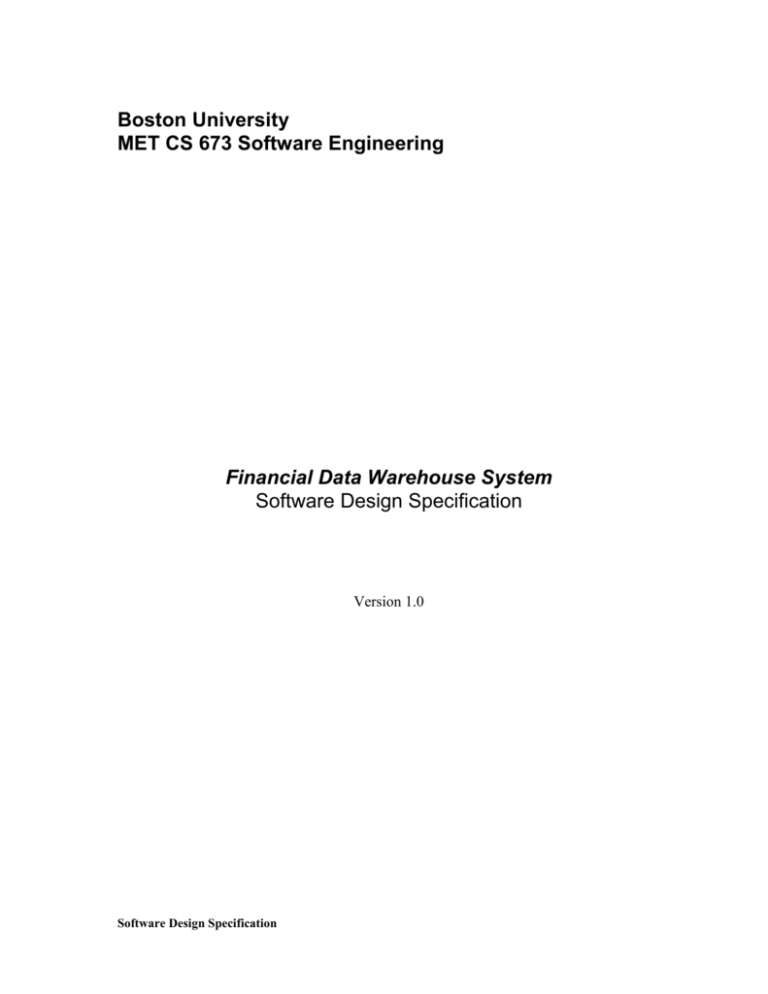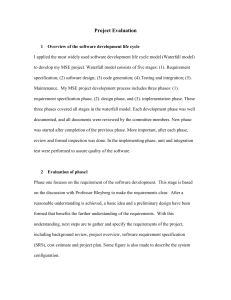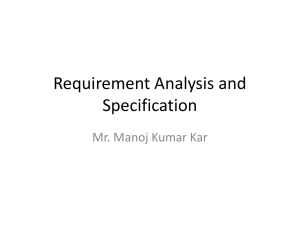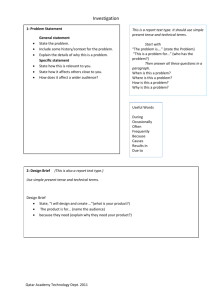1.0
advertisement

Boston University
MET CS 673 Software Engineering
Financial Data Warehouse System
Software Design Specification
Version 1.0
Software Design Specification
Approvals
P.Aldrich __Philip Aldrich___Date:__07/08/04__
R.Balter ___Ryan Balter_____Date: __07/08/04__
J. Guan ___John Guan______Date: __07/08/04__
G.Santhanam _Gowtham Santhanam__ Date: __07/08/04__
C. Soto__Carlos Soto______ Date: __07/08/04__
AP Kantinan ___Apisit Kantinan____ Date: __07/08/04__
J. Quian__ Zhiming Quian_ Date: __07/08/04__
PK Parameswaran _PK Parameswaran_ Date: __07/08/04__
Revision History
Date
Author
Description
06/24/04
Zhiming Qian
Initial Draft
07/07/04
Gowtham Santhanam
Updated document after discussing
with project team
Software Design Specification
TABLE OF CONTENTS
1.
INTRODUCTION ............................................................................................................................... 4
1.1
1.2
1.3
PURPOSE ....................................................................................................................................... 4
SCOPE ........................................................................................................................................... 4
DEFINITIONS, ACRONYMS, AND ABBREVIATIONS ......................................................................... 4
2.
REFERENCES .................................................................................................................................... 4
3.
DECOMPOSITION DESCRIPTION ................................................................................................ 5
3.1
3.2
3.3
3.4
3.5
4.
DEPENDENCY DESCRIPTION ....................................................................................................... 8
4.1
4.2
4.3
4.4
4.5
5.
INTER-MODULE DEPENDENCIES (OBJECT MODEL) ....................................................................... 9
INTER-PROCESS DEPENDENCIES .................................................................................................... 9
DATA DEPENDENCIES.................................................................................................................... 9
STATE DEPENDENCIES................................................................................................................... 9
LAYER DEPENDENCIES .................................................................................................................. 9
INTERFACE DESCRIPTION ........................................................................................................... 9
5.1
5.2
6.
MODULE DECOMPOSITION ............................................................................................................ 5
CONCURRENT PROCESS DECOMPOSITION ..................................................................................... 6
DATA DECOMPOSITION ................................................................................................................. 6
STATE MODEL DECOMPOSITION ................................................................................................... 6
USE CASE MODEL DECOMPOSITION ............................................................................................. 8
MODULE INTERFACES ................................................................................................................... 9
PROCESS INTERFACE ..................................................................................................................... 9
DETAILED DESIGN OF FDW PACKAGE .................................................................................. 10
6.1
THE DATAWAREHOUSE PACKAGE.............................................................................................. 11
Class UserManager ............................................................................................................................. 11
Class ScreenFlowManager.................................................................................................................. 12
Class FDWBaseServlet ........................................................................................................................ 12
Class ReportServlet ............................................................................................................................. 13
Class RptByBusinessUnit .................................................................................................................... 13
Class RptByTime ................................................................................................................................. 14
Class RptByFund ................................................................................................................................. 15
Class RptExecutiveSummary ............................................................................................................... 15
6.2
SEQUENCE DIAGRAMS ................................................................................................................ 16
sequence diagram for use case valid login .......................................................................................... 16
sequence diagram for Invalid log in use case...................................................................................... 16
sequence diagram for report by time ................................................................................................... 17
sequence diagram for use case report by business unit ....................................................................... 17
sequence diagram for report by fund................................................................................................... 18
sequence diagram for use case non-managed executive summary ...................................................... 19
sequence diagram for searching .......................................................................................................... 19
6.3
DATA DETAILED DESIGN ............................................................................................................ 20
6.3.1 Table: tblBusinessUnit ............................................................................................................... 20
6.3.2 Table: tblFund ............................................................................................................................ 20
6.3.3 Table: tblSalesAndAssets ............................................................................................................ 21
6.3.4 View: vRptByBusinessUnit ......................................................................................................... 21
Software Design Specification
6.3.5 view: vRptByFund....................................................................................................................... 21
6.3.6 View: vRptNonManagedExecutiveSummary .............................................................................. 21
6.3.7 View: vRptManagedExecutiveSummary ..................................................................................... 22
6.3.8 View: vRptByTime ...................................................................................................................... 22
6.3.9 Table: tblUsers ........................................................................................................................... 22
1. Introduction
1.1 Purpose
This document describes the database architecture and application architecture for
the Financial Data Warehouse project.
1.2 Scope
This document covers the design specifications for release 1.0 of Financial Data
Warehouse. This document encompasses system design, which deals with the overall
organization of the system, also referred to as the system architecture, as well as object
design, which deals with the definition of the classes used in the implementation. The
classes come from the application domain analysis. The purpose of this document is to
guide developers in the implementation of the Financial Data Warehouse system.
1.3 Definitions, Acronyms, and Abbreviations
Acronym or
Term
FDW
GUI
RDBMS
SDS
SRS
TBD
Definition
Financial Data Warehouse System
Graphical User Interface
Relational Database Management System
Software Design Specification
Software Requirements Specification
To Be Determined
2. References
Software Configuration Management Plan (SCMP) for FDW version 1.0
Software Project Management Plan (SPMP) for FDW version 1.0
Software Requirements Specification (SRS) for FDW version 1.0
Software Quality Assurance Plan (SQAP) for FDW version 1.0
Software Test Documentation (STD) for FDW version 1.0
Software Design Specification
Braude, E. J., Software Engineering: an Object-oriented perspective
3. Decomposition Description
3.1 Module Decomposition
FDW will only have one package – the Data Warehouse Package.
Figure 3.1 shows the layered architecture selected for the FDW.
The client layer sends a reporting request to the application layer. When the application
layer receives a request, it sends a query to the database layer. The database layer
executes the query and returns the result back to the application layer. The application
layer generates a dynamic report based on the result.
Figure 3.1 System Architecture
Data in a data warehouse is organized to support analysis rather than to process real-time
transactions as in online transaction processing systems. Organizations collect data in the
normal course of business operations. The purpose of a data warehouse is to consolidate
and organize this data so it can be analyzed and used to support business decisions.
Figure 3.2 shows the architecture of the database systems.
In general enterprise data are highly heterogeneous in format. This system
supports the various data sources in the following format: Oracle database, SQL
Server database, Access Jet Database, Excel data file, plain text data file with
predefined formats (comma separated file, or tab separated file etc.) Microsoft
supports numerous drivers for collecting heterogeneous data. For simplicity this
project will use flat text file for demonstration, but the system is designed to be
flexible enough, and is not limited to flat file data source.
The uploading of the data into data warehouse database is supported by Data
Transition Service, bcp utility or bulk insert T-SQL statements. Database
Software Design Specification
developer or administrator may choose one or any combination of these uploading
mechanisms according his/her needs.
In order to facilitate analysis of enterprise data, database table are reorganized by
dimensions such as time, product, business unit, etc. Stored procedures and
predefined queries (views) are created on database.
Figure 3.2 Database Architecture
3.2 Concurrent Process Decomposition
The FDW will not have concurrent processes. Multiple user clients may use the system
at the same time since the DBMS will ensure exclusive accesses.
3.3 Data Decomposition
The data structures flowing among the package are defined by the
RptByBusinessUnit, RptByFund, RptByTime, and RptExecutiveSummary
classes
3.4 State Model Decomposition
State Transition Diagram for Financial data warehouse
Software Design Specification
Log In( Authorized User )
Logged In
Navigate to reports
Software Design Specification
View/Search Business Unit
and Fund Reports
3.5 Use Case Model Decomposition
Valid Login
Invalid Login
Non Managed Report
Business Unit Report
User
Fund Report
Fund by Time Report
Search
4. Dependency Description
Software Design Specification
This section describes the dependencies for the various decompositions
described in section 3.
4.1 Inter-module Dependencies (Object Model)
The dependencies among package interfaces are shown in figure 6.0.
4.2 Inter-process dependencies
NA
4.3 Data dependencies
NA
4.4 State dependencies
NA
4.5 Layer dependencies
NA
5. Interface Description
This section describes the interfaces for the object model.
5.1 Module interfaces
NA
5.2 Process interface
NA
Software Design Specification
6. Detailed Design of FDW Package
The overall architecture of the package described in this section can be found in
the figure below
Figure 6.0
Software Design Specification
6.1 The DataWarehouse Package
Class UserManager
The design of this class satisfies requirement 2.2.2 and 3.2.2.LO in the SRS
Class UserManager Should be implemented as a Singleton pattern
Attributes:
UserHash - a HashTable storing which users are logged on the system.
Methods:
Public bool validate(String username, String password){
/*
check database tblUsers for username and password
if it matches, return true; add userID to UserHash
else return false;
*/
}
public bool isLoggedOn(username){
/*
check if the username is in userHash
return true/false;
*/
}
public Static UserManager getInstance(){
//return a unique instance
}
Software Design Specification
Class ScreenFlowManager
The design of this class satisfies requirement 2.2.3 – 2.2.8 and 3.2.2BU, 3.2.2FU in the
SRS
Class ScreenFlowManager Should be implemented as a singleton.
Public Class ScreenFlowManager{}
Methods:
Public String getNextPage(String action){
/*
forward to next jsp/ servelet according to the action user requested
if action = “LOGIN” then return executive summary report page
if action = “BYTIME then return byTime report page
if action = “BYBUSINESSUNIT” then return … etc.
*/
}
public Static ScreenFlowManager getInstance() {
//return a unique instance
}
Class FDWBaseServlet
Public Class FDWBaseServlet extends HttpServlet
Attributes:
Private Connection conn;
Methods:
Protected void getConnection(){
Conn = DriverManager.getConnection(jdbc:odbc:datasoureName, username,
pwd);
…
}
Software Design Specification
Class ReportServlet
The design of this class satisfies requirement 2.2.3 – 2.2.8 and 3.2.2BU, 3.2.2FU in the
SRS
Public abstract Class ReportServlet extends FDWBaseServlet
Attributes:
Private String reportName;
Private int intNumColumns;
Private int intNumRows;
Private ResultSet resultSet;
Private ResultSetMetaData resultSetMetaData;
Private String strQuery;
Methods:
public void executeQuery(){
//execute query
}
public abstract void displayResult(){
//display the query result to screen
}
Public void service(HttpServletRequest req, HttpServletResponse rep){
ExecuteQuery();
DisplayResult();
…;
}
ReportServlet and detailed implementation of 5 reports should be implemented by
design pattern Factory Method.
Class RptByBusinessUnit
The design of this class satisfies requirement 2.2.3 – 2.2.5, 2.2.8 and 3.2.2BU in the
SRS
Software Design Specification
public Class RptByBusinessUnit extends ReportServlet{}
Attributes:
Private String strQuery = “select … ”
//predefined query string for this specific report
Methods:
Public void displayResult(){}
/*this methods overrides the method in base class.
Displays the query result in format for this report
*/
}
Class RptByTime
The design of this class satisfies requirement 2.2.78 and 3.2.2FU in the SRS
public Class RptByTime extends ReportServlet{}
Attributes:
Private String strQuery = “select … ”
//predefined query string for this specific report
Methods:
Public void displayResult(){}
/*this methods overrides the method in base class.
Displays the query result in format for this report
*/
}
Software Design Specification
Class RptByFund
The design of this class satisfies requirement 2.2.6, 2.2.8 and 3.2.2FU in the SRS
public Class RptByFund extends ReportServlet{}
Attributes:
Private String strQuery = “select … ”
//predefined query string for this specific report
Methods:
Public void displayResult(){}
/*this methods overrides the method in base class.
Displays the query result in format for this report
*/
Class RptExecutiveSummary
The design of this class satisfies requirement 2.2.3 – 2.2.5, 2.2.8 and 3.2.2BU in the
SRS
Public Class RptExecutive Summary extends ReportServlet{}
Attributes:
Private String strQuery = “select … ”
//predefined query string for this specific report
Methods:
Public void displayResult(){}
/*this methods overrides the method in base class.
Displays the query result in format for this report
*/
Software Design Specification
6.2 Sequence Diagrams
sequence diagram for use case valid login
This sequence diagram satisfies requirement 2.2.1 in the SRS
sequence diagram for Invalid log in use case
This sequence diagram satisfies requirement 2.2.2 in the SRS
Software Design Specification
sequence diagram for report by time
This sequence diagram satisfies requirement 2.2.6 in the SRS
sequence diagram for use case report by business unit
This sequence diagram satisfies requirement 2.2.4 in the SRS
Software Design Specification
sequence diagram for report by fund
This sequence diagram satisfies requirement 2.2.5 in the SRS
Software Design Specification
sequence diagram for
summary
use case non-managed
This sequence diagram satisfies requirement 2.2.3 in the SRS
sequence diagram for searching
This sequence diagram satisfies requirement 2.2.7 in the SRS
Software Design Specification
executive
6.3 Data Detailed Design
The following are the designs for the database tables and views that are used in the FDW
system. These tables are for input data: tblBusinessUnit, tblFund, tblSalesAndAssets;
These views are query results for reporting to screen: vRptByBusinessUnit, vRptByTime,
vRptByFund, vRptManagedExecutiveSummary, vRptNonManagedExecutiveSummary
6.3.1 Table: tblBusinessUnit
6.3.2 Table: tblFund
Software Design Specification
6.3.3 Table: tblSalesAndAssets
6.3.4 View: vRptByBusinessUnit
6.3.5 view: vRptByFund
6.3.6 View: vRptNonManagedExecutiveSummary
Software Design Specification
6.3.7 View: vRptManagedExecutiveSummary
6.3.8 View: vRptByTime
6.3.9 Table: tblUsers
Software Design Specification









